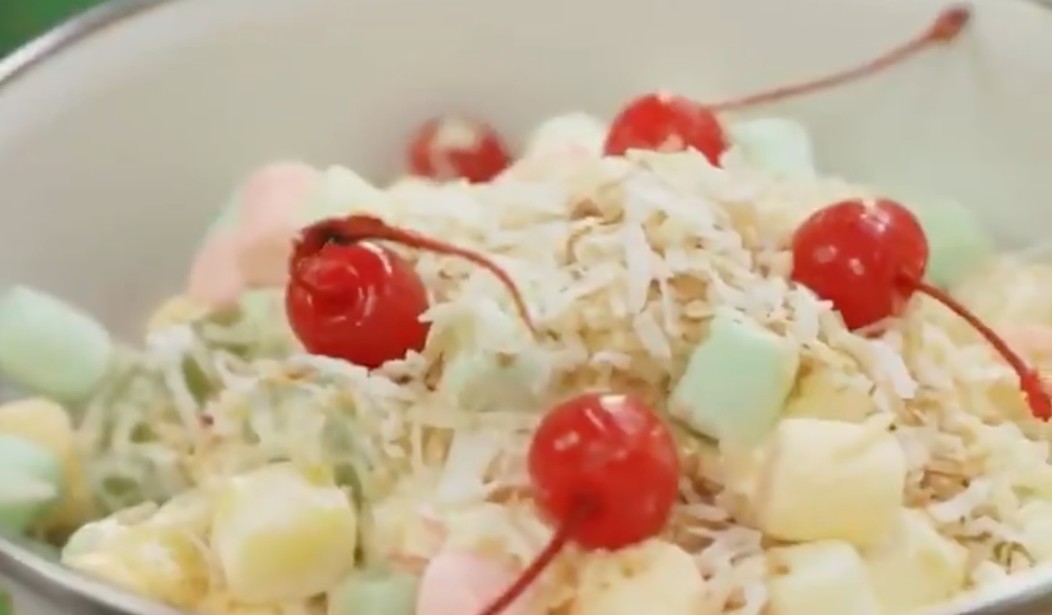Somewhere in the mid-20th century, there was a food trend of mixing random things – usually involving canned fruit cocktail – with some sort of sauce, cream, or dressing and calling it “salad.”
I’ve been feeling pretty nostalgic lately, looking at old family recipes and seeing some of these recipes crop up every now and then. There are some that I refuse to try, like pear salad.
An article I read said that this is a dish people should make and eat.
That's:
Lettuce
Pear
Mayo
Cheese
Cherries…
Together. pic.twitter.com/DwDBry4Gpw— Outlaw Poet (@Outlawpoet1970) October 20, 2022
If someone put that on a plate and gave it to me, we would be having words. I am not sure how that qualifies as a salad, and it’s an affront to pears. Every ingredient on it is fine, but putting them together like that seems wrong. The latter half of the 20th century was apparently a lawless wasteland of dishes made cheaply.
But there is perhaps one that is due for a more mainstream comeback. My family has started adding it to the holiday menu again, and I actually hope others do as well. It’s a sweet, but not rich, side dish that can take the edge off so many savory dishes that normally get served at big family gatherings. It’s called ambrosia salad (or just ambrosia), and it’s marvelous.
At first glance, it can definitely come off as rich, given how obnoxiously sweet canned fruit can be, and then you combine it with marshmallows and some sort of cream (recipes seem divided between using sour cream and whipped cream). Throw in some shredded coconut, maybe some nuts, and some cherries on top and you’ve got a colorful dish that can really help lighten a meal.
Here’s one version.
.@mattymatheson's ambrosia salad mixes sour cream, marshmallows and canned fruit.
(via @getstack) pic.twitter.com/fiNZLA9XLz
— VICE Canada (@vicecanada) December 4, 2018
I think it’s the use of these multi-colored marshmallows that just makes the dish look so bright and cheerful. It’s pleasing to the eye.
Because of its sweetness, though, there is sometimes a debate as to whether or not it’s a dessert or a side dish. We’ve always had it served as a side. Like I said, with all the savory foods that get served around the holidays at those big family gatherings, it’s nice to have something sweet to take the edge off. Put it right next to the green bean casserole.
The history of the dish is a fascinating one. The dish itself dates back to the late 1800s, but in the 1900s it began to explode in popularity.
Ambrosia began appearing in cookbooks in the late 1800s when citrus fruit became more prevalent in markets across the United States. These early recipes were very simple, usually including only orange slices, coconut, and sugar layered in a glass dish. As ambrosia’s popularity grew, many versions began to emerge, often with conflicting advice. For instance, Mary D. Pretlow’s Calendar of Old Southern Recipes warned, “You must not use canned coconut,” while James Beard’s Fireside Cook Book said, “The moist canned coconut is best for this.”
Throughout the 20th century, southern cooks, in particular, began to transform this dish into a more diverse fruit salad. I’ve been served ambrosia prepared traditionally, but also with grapefruit, banana, pineapple, maraschino cherries, raisins, nuts, and marshmallows. I’ve seen it topped with sugar, whipped cream, yogurt, and, once, mayonnaise. When our beloved café was in operation, I asked our team to develop their own recipe for ambrosia. The result: a delicious coconut milk tapioca soup with citrus compote and vanilla bean shortbread. This take is far from traditional, but the flavors are all there – coconut, citrus, and a hint of sweet vanilla. Regardless of the ingredients, ambrosia salad is best served on the day of preparation. The sugar can cause the oranges (and other fruits used) to release their juices and the dish can turn to mush in a matter of hours.
You can find dozens of variations almost instantly in any search engine, but the best versions will definitely be scrawled down on an old, faded recipe card your grandmother, great-grandmother, or some other relative kept decades ago for reference.














Join the conversation as a VIP Member